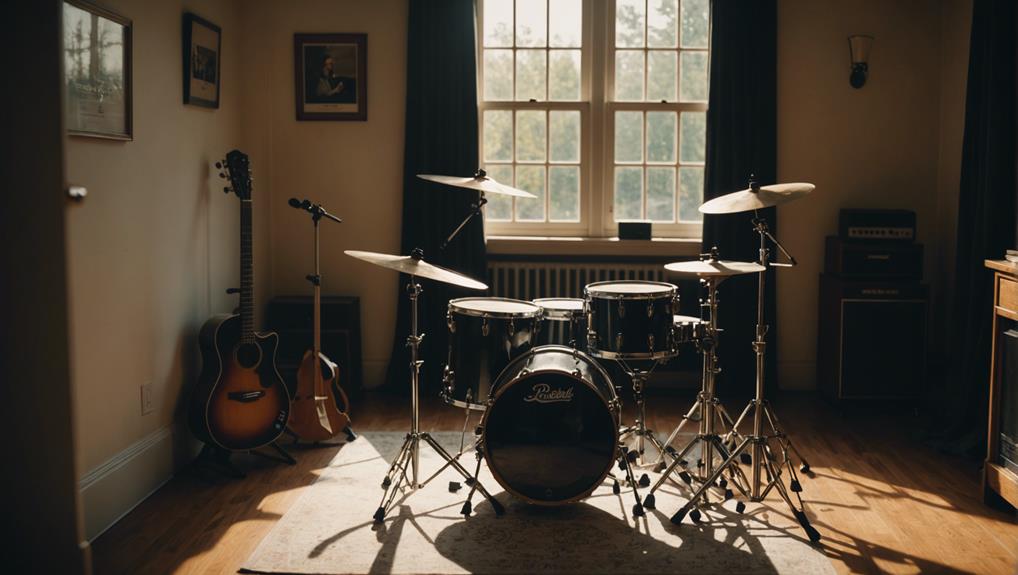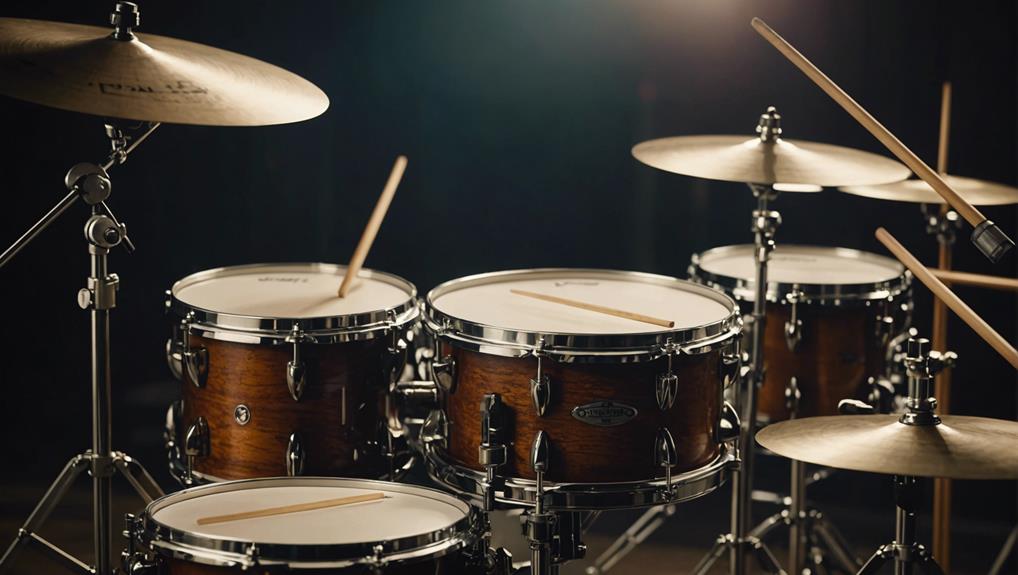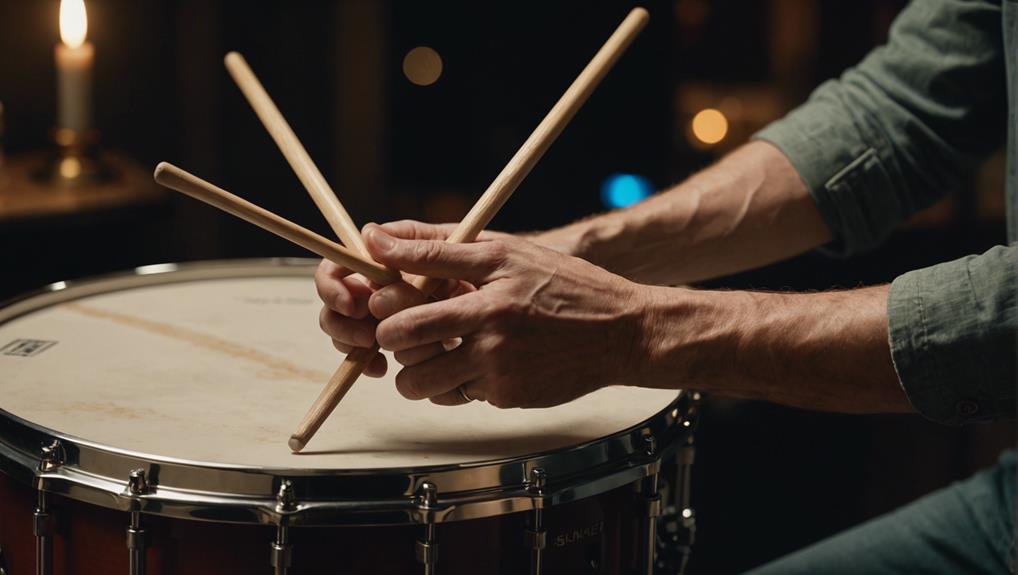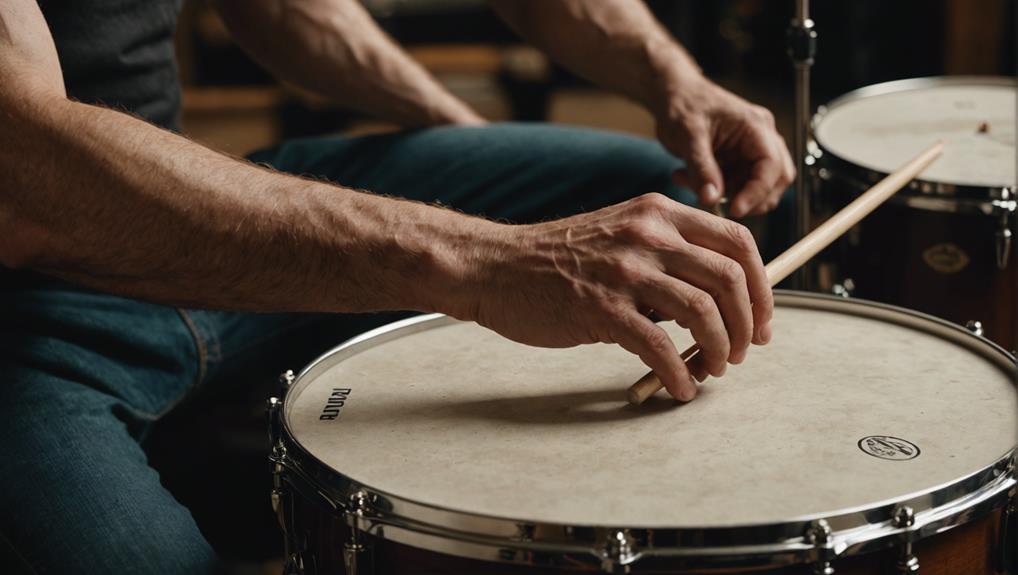When you start practicing drums, the first step is to set clear goals. Without them, your practice sessions can become aimless and frustrating. Think about what you want to accomplish, whether it’s mastering a specific song, improving your timing, or learning new rudiments. By breaking down your objectives, you can create a structured plan that keeps you focused and motivated. But goal-setting is just the beginning. Have you considered the tools and techniques that can enhance your drumming skills? There are some surprising methods that might change how you approach your practice sessions.
TL-DR
- Set specific, measurable drumming goals to focus efforts and track progress.
- Use practice tools like pads and metronomes to enhance stick control and timing.
- Practice rudiments daily to build technical skills, muscle memory, and coordination.
- Customize practice sessions with drumming apps and DIY drum kits for variety.
- Engage with drumming communities for motivation, networking, and shared learning.
Set Clear Goals
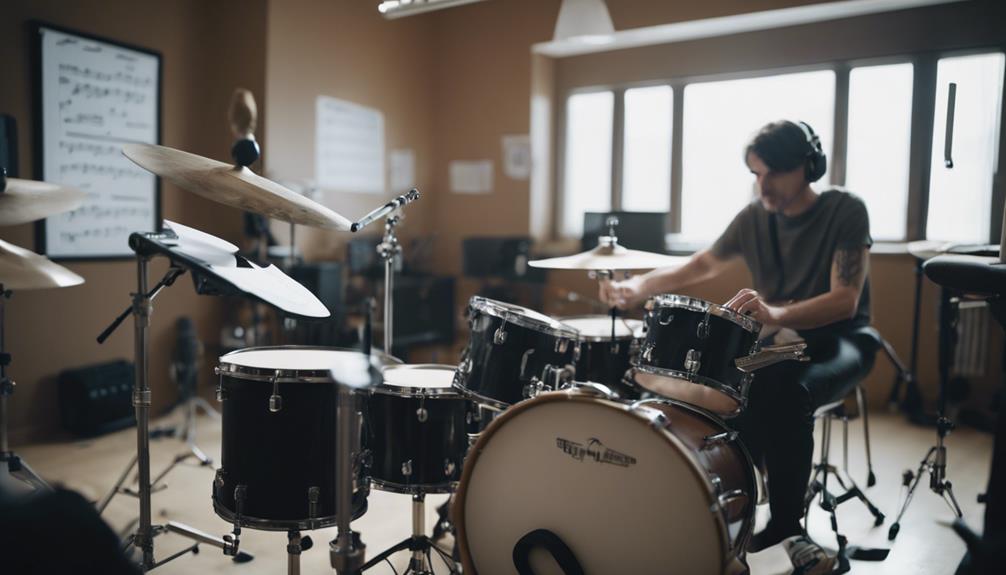
Setting clear goals in your drum practice is essential for focusing your efforts and measuring your progress effectively. To begin, outline specific goals such as mastering a particular rudiment or improving your tempo accuracy. These goals provide direction, ensuring each practice session has a purpose.
For instance, you might aim to increase the BPM on a specific exercise. Quantifiable goals like this make it easy to track your progress. By noting your starting point and regularly measuring improvements, you can see how far you’ve come. This method keeps your practice sessions structured and goal-oriented.
Clear goals also keep you motivated. When you know exactly what you’re working towards, it’s easier to stay disciplined and consistent. You won’t just be playing the drums but practicing with intent. This focus accelerates your learning and skill development.
Lastly, setting achievable goals fosters a sense of accomplishment. Each time you hit a milestone, whether it’s mastering a new beat or reaching a higher BPM, you’ll gain confidence. This confidence fuels further progress, creating a positive cycle of continuous improvement.
Utilize Practice Pads
To improve your stick control and reduce noise levels, practice pads are your best friend. They mimic the feel of drum heads, letting you refine your technique without disturbing others.
Using them regularly can lead to better control, consistency, and precision in your drumming.
Improve Stick Control
Exploring practice pads can greatly enhance your stick control by providing a responsive surface for practicing sticking and rudiments. Practice pads are essential tools for improving your hand technique, as they help you develop precision, speed, and accuracy.
Let’s explore how you can use practice pads to improve your stick control.
First, different practice pad sizes cater to various techniques. For instance, smaller pads are excellent for focusing on snare drum patterns, while larger pads can simulate the feel of a full drum set. By practicing on different sizes, you can improve your coordination and adaptability.
Next, incorporating kick pads into your practice routine allows you to work on your foot technique. This is particularly useful for drummers who want to enhance their overall drumming skills by ensuring both their hands and feet are well-coordinated.
Regular use of practice pads offers several benefits:
- Enhanced hand technique: Repeated practice on pads refines your grip and motion.
- Improved precision: The responsive surface helps you develop accurate sticking.
- Increased speed: Consistent practice builds muscle memory and quickness.
- Better control: Fine-tune your dynamics and strokes for more controlled playing.
Reduce Noise Levels
Practice pads offer a vital solution for drummers who need to work on their technique without causing a disturbance. These handy tools are designed to reduce noise levels while still giving you the feel of playing on a real drum head. They come in various sizes and materials, allowing you to simulate different drum surfaces. This makes them perfect for home and apartment settings where keeping the noise down is essential.
Using practice pads regularly can greatly improve your sticking technique and hand control. Because you’re not worrying about disturbing others, you can focus entirely on refining your skills. Practice pads allow you to isolate specific techniques, helping you to make precise adjustments to your playing style.
Incorporating practice pads into your daily routine isn’t just about reducing noise levels; it’s about enhancing your overall drumming abilities. You’ll find that consistent practice on a pad translates well to your actual drum set. The quieter environment allows for more concentrated practice sessions, leading to faster progress.
Explore Air Drumming

Air drumming offers a silent and versatile way to sharpen your rhythm and coordination skills without needing actual drums. This practice method involves simulating drumming movements in the air, letting you practice drums without the need for a physical drum set. It’s especially useful for honing your drumming skills when you’re on the go or in places where noise is a concern.
Incorporating air drumming into your routine can help you:
- Enhance muscle memory by mimicking hand and foot movements.
- Improve timing and rhythm without disturbing others.
- Practice anywhere, making it a convenient option.
- Focus on specific drumming techniques and patterns.
Air drumming isn’t just about waving your arms around aimlessly. Pay attention to your form and try to visualize an actual drum set in front of you. This mental exercise can notably enhance your drumming accuracy and coordination.
For an even more immersive experience, consider using tech gadgets like DrumPants or Aerodrums. These devices can produce virtual drum sounds, adding an audio element to your practice.
Experiment With Body Percussion
Why not add some variety to your drumming practice by experimenting with body percussion? Body percussion involves creating rhythmic sounds by tapping, clapping, or slapping different parts of your body, making it an excellent way to practice without a drum. This method not only helps with rhythm and coordination but also adds a fun, creative twist to your routine.
Start by tapping your thighs, clapping your hands, and snapping your fingers to create simple rhythms. You can further diversify the sounds by incorporating loose items like coins or keys in your pockets. These can mimic the varied sounds of a drum kit, adding richness to your practice sessions.
Don’t forget to include beatboxing—a form of vocal percussion. By combining vocal beats with body percussion, you’ll develop a more holistic sense of timing and rhythm. This approach helps internalize rhythmic patterns, making you more adept when you return to your actual drum set.
Experimenting with body percussion isn’t just a creative exercise; it’s a practical way to enhance your drumming skills. So, next time you’re looking to change things up, give body percussion a try. You’ll find it’s both effective and enjoyable.
Try DIY Drum Kits

Creating your own DIY drum kit using household items like pillows, pots, and pans is both affordable and customizable. You can experiment with different textures to mimic real drum surfaces and adjust the sound.
This approach not only saves money but also allows for quieter practice sessions, perfect for apartments or noise-sensitive environments.
Affordable Practice Solutions
Homemade drum kits using items like pillows, pots, and cardboard boxes provide a budget-friendly way to practice drumming. If you’re tight on cash but still want to improve your skills, creating DIY drum kits from household items is an excellent solution. These makeshift drum kits not only save money but also help you practice quietly, which is perfect if you live in a noise-sensitive environment.
Using DIY drum kits can be surprisingly effective for your drumming practice. You can enhance your sticking techniques and rhythm without needing to invest in expensive equipment. Here are some items you can use to get started:
- Pillows and cushions: Great for practicing stick control and dynamics.
- Pots and pans: Useful for mimicking the feel and sound of different drum surfaces.
- Cardboard boxes: Excellent for creating a makeshift bass drum or toms.
- Plastic containers: Perfect for simulating snare drums or additional percussion.
Making the shift from DIY kits to traditional drum sets later on can further enhance your skills and creativity. You’ll find that the techniques you honed on your homemade kit will easily translate to a standard drum set. Plus, you get the added benefit of having customized your practice routine from the ground up.
Customizable Sound Options
Exploring customizable sound options with DIY drum kits can elevate your practice sessions by allowing you to tailor each component to your unique style. Creating a DIY drum kit isn’t only a cost-effective alternative to traditional drum sets but also a fantastic way to experiment with different sounds. You can use unconventional items like buckets, pots, and pans to produce unique drum sounds that reflect your personal preferences.
DIY drum kits offer incredible flexibility, letting you adjust your setup to suit various playing styles and genres. If you’re into jazz, you might opt for lighter, more resonant materials, whereas rock enthusiasts could choose sturdier, louder options. This customizability helps you develop creativity and resourcefulness, essential skills in the drumming world.
Moreover, assembling your own DIY drum kit can be a fun and educational experience. You’ll gain a deeper understanding of how different materials and configurations affect sound. This hands-on approach can make your practice sessions more engaging and enjoyable.
Use Drumming Apps
Leveraging drumming apps can elevate your practice sessions by offering interactive lessons, diverse drum loops, and expert video tutorials. Using these apps lets you explore new techniques, practice with drum loops, and follow interactive drum lessons tailored to your skill level.
Drumming apps like ‘Drum School’ provide a wide range of lessons covering various styles and techniques, making it easier for you to progress.
Apps like ‘Drum Beats+’ are perfect for practicing with drum loops, offering a broad variety of loops and backing tracks. This keeps your practice sessions dynamic and engaging.
‘Drum Guru’ features video lessons from top drummers, giving you access to professional insights and advanced techniques you can incorporate into your playing.
To get the most out of these drumming apps, consider the following:
- Explore different styles: Use apps to learn various genres and techniques.
- Set practice goals: Track your progress and set specific goals.
- Follow expert tutorials: Learn from video lessons by professional drummers.
- Utilize backing tracks: Practice with diverse drum loops to improve your timing and versatility.
Practice With a Metronome

Using a metronome while practicing drums is essential for developing precise timing and rhythmic consistency. It helps you maintain a steady tempo, which is vital for any drummer. When you practice with a metronome, you’re training your internal clock, making it easier to keep time naturally, even when you’re not using one.
Start by setting the metronome to a comfortable tempo. Play simple beats, focusing on aligning each stroke with the metronome’s clicks. As you get comfortable, gradually increase the tempo to challenge yourself. This practice enhances your versatility, enabling you to play at various speeds without losing accuracy.
Recording yourself while playing with a metronome can be incredibly beneficial. When you listen back, you’ll notice any timing discrepancies, enabling you to pinpoint areas needing improvement. This feedback loop is vital for your growth as a drummer.
Consistency is key. Regularly practicing with a metronome will solidify your sense of timing and make you a more reliable musician. It might feel challenging at first, but don’t get discouraged. Stick with it, and you’ll find your timing and rhythm improving significantly over time.
Learn Rudiments
As you refine your timing with a metronome, it’s equally important to focus on learning rudiments to build your technical drumming skills. Drum Rudiments are essential exercises that focus on specific sticking patterns, helping you develop coordination and precision. Incorporate these into your drum practice routine to enhance your technique and become a more versatile drummer.
There are 40 standard drum rudiments recognized by the Percussive Arts Society. These range from simple single stroke rolls to complex flam accents. Practicing these rudiments regularly will improve your dexterity, speed, control, and overall drumming proficiency.
Consider these benefits of learning rudiments:
- Improve muscle memory and coordination.
- Develop better control and accuracy.
- Increase your speed and agility.
- Enhance your overall drumming technique.
Make rudiments a core part of your warm-up exercises. Start slow, focusing on accuracy, and gradually increase your speed as you become more comfortable. Consistency is key, so integrate rudiment practice into your daily routine. Use a metronome to confirm you’re playing in time and pay attention to your hand movements and grip.
Join Drumming Communities

Connecting with drumming communities can greatly enhance your skills and motivation. By joining online platforms like Drummerworld or Drum Chat, you’ll engage in valuable networking and share tips with fellow drummers. These communities offer a wealth of knowledge where you can ask questions, discuss practice techniques, and stay updated on the latest trends.
Locally, participating in drum circles or meetup groups helps you connect with drum enthusiasts in your area. These gatherings provide a supportive environment for practicing and learning new rhythms. Plus, there’s nothing quite like the energy of a live, collaborative drumming session to keep you inspired.
Attending drumming workshops, clinics, or masterclasses is another excellent way to expand your skill set. Experienced professionals often lead these events, offering insights and techniques you mightn’t encounter otherwise.
Social media groups and forums dedicated to drumming are also invaluable. Engage with these communities to follow industry news and discover innovative practice methods. Platforms like Splice or Soundtrap enable you to collaborate with other drummers, creating music and exchanging ideas from the comfort of your home.
Incorporating these networking opportunities into your routine will enrich your practice and elevate your drumming journey.
Next up, learn how to setup a drum set in this guide.
